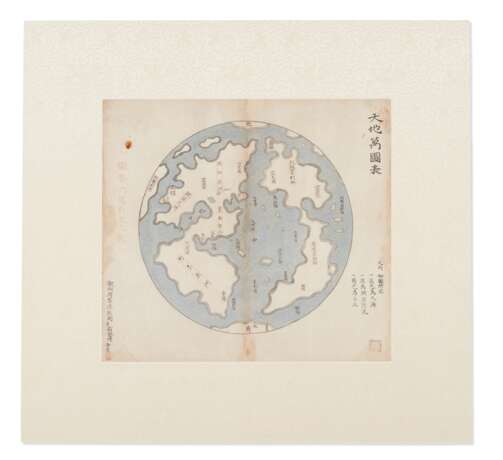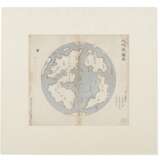ID 627586
Lot 97 | Manuscript "Chart of the Vast World"
Valeur estimée
$ 2 000 – 3 000
A handsome manuscript map of the globe. With north at the top, the map shows the Asia-Euro continent and Africa on the left, the Americas on the right, Gronlanda (the present Greenland) at the left, and the north and south poles. The cartographical guide written at the lower right corner indicates that blue represents the seas, green for lakes and rivers, and ochre for hills. However, no rivers and hills are painted in the map. Scientific maps employing Western techniques of cartography entered China with the arrival of Jesuits since the sixteenth century, and were embraced by the intellectuals. However, map making with traditional Chinese painting methods never died out. The present lot is a charming combination of conventional presentation of Chinese art and modernized concepts of Western knowledge.
The source of single hemisphere map like the present lot can be traced back to Matteo Ricci (1552-1610), who painted similar while he was in Guangdong (such as Shanhai Yudi Quantu) and before he moved to Nanchang and then Beijing (Tam). As the signature at the lower left corner of the present lot reads, the map was “painted and produced by your servant Yu Dengfeng at the government office of Wuyuan County, Huizhou Prefecture.” This reveals that the recipient of the present lot should be the emperor. The oval seal at the upper right corner reads kejian qishi (announcement of being restraint and frugal), probably a personal seal of the cartographer. No records of Yu Dengfeng can be found, but he shares the same generation name “deng” with Yu Dengying, father of the magistrate of Wuyuan County in early Qianlong’s reign, Yu Yungeng (a. 1730-1760). (Feng) The artist of the present lot, might start serving for the government office of Wuyuan County after his younger relative being appointed the position of magistrate. Along the left margin of the map, an inscription, probably by a collector, says “viewed by the owner of Liu Yi Xuan (Cottage of Six Regrets) from Wuyuan County, Huizhou Prefecture.” The pale red color of the inscription is so similar to the frames surrounding the place names in the globe that the frames maybe added by this collector rather than the cartographer. Since this map was supposed to be presented to the emperor, it’s unlikely that a local collector would write inscriptions on it. A further inference is that the present lot might be a draft of the map for the emperor, which is probably more detailed, with green lakes and rivers, as well as ochre hills, as described in the cartographical guide. A collector’s seal at the lower right corner, reading Xianhe, probably the name or sobriquet of the owner of Cottage of Six Regrets. References: Kwong-Lim Tam, Cong Fangyuan dao Jingwei: Xianggang yu Huanan Lishi Ditu Zhencang [From Circular and Square Shapes to Meridian and Parallel Lines: Collected Treasures of Historical Maps of Hong Kong and South China] (2010), pp. 52-53, pl. 24; Guifen Feng, Suzhou Fu Zhi (Gazetteer of Suzhou Prefecture), vol. 97 (1882).
Manuscript map of the globe, ink and color on paper, mounted as an album leaf with silk borders, the central fold shows that it was originally a vertical album, approximately 535 x 570 mm including mounting. Title at the upper right corner, signature and seal of the artist at the lower left corner, text in Chinese. Contours of the globe and continents drawn with dark grey lines, light gray outline color for contours for the continents, ocean painted in cobalt blue with patterns of wave, place names written in ink with light red frames. (Slight toning, wear and browning along central fold, some narrow dampstaining to edges, several tiny holes and a rust stain.)
Please note that this lot is subject to an import tariff. If the buyer instructs Christie’s to arrange shipping of the lot to a foreign address, the buyer will not be required to pay the import tariff. If the buyer instructs Christie’s to arrange shipping of the lot to a domestic address, if the buyer collects the property in person, or if the buyer arranges their own shipping (whether domestically or internationally), the buyer will be required to pay the import tariff. Please contact Post Sale Services on +1 212 636 2650 prior to bidding for more information.
| Artiste: | William Shakespeare (1564 - 1616) |
|---|---|
| Technique appliquée: | Crayon |
| Artiste: | William Shakespeare (1564 - 1616) |
|---|---|
| Technique appliquée: | Crayon |
| Adresse de l'enchère |
CHRISTIE'S 8 King Street, St. James's SW1Y 6QT London Royaume-Uni | |
|---|---|---|
| Aperçu |
| |
| Téléphone | +44 (0)20 7839 9060 | |
| Commission | see on Website | |
| Conditions d'utilisation | Conditions d'utilisation |












